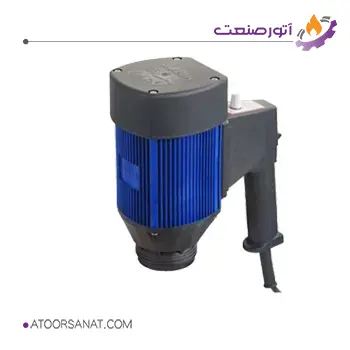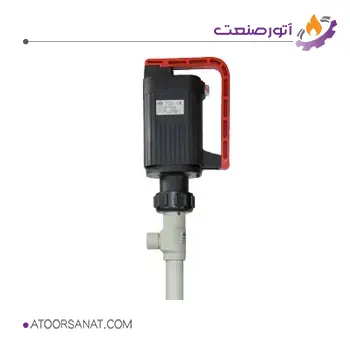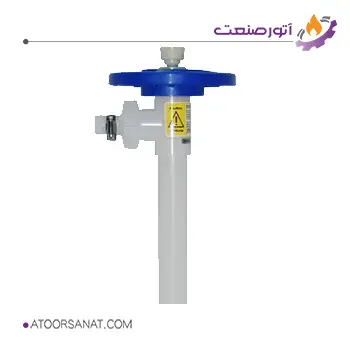Drum Pump

What is a barrel Drum pump (drum pump)?
A barrel drum pump, also known as a drum pump, is used to quickly and safely transfer various fluids, such as water, chemicals, acids, bases, solvents, fuels, etc., with different viscosities and chemical properties, from tanks or drums to various industries such as chemical plants, food processing plants, etc. The power source of these pumps is usually manual, electric, or pneumatic, and is selected based on the type of fluid, application, and available power source. These portable pumping equipment are available in metal and non-metal (plastic) materials to minimize corrosion and damage when used for corrosive fluids.

Features:
- Country of origin: Germany
- Maximum flow rate: 70 liters per minute
- Applications: For transferring petroleum – based materials such as solvents, oils, greases, etc.

Features:
- Country of origin: India
- Maximum flow rate: 40 liters per minute
- Applications: For transferring gasoline, diesel, low-temperature viscous fluids, etc.

Features:
- Country of origin: Taiwan
- Maximum flow rate: 90 liters per minute
- Body material: PP – PVDF and stainless steel
- Applications: Transferring various types of oils, resins, solvents, acids and bases, essences, milk, honey, yogurt, paint, alcohol, etc.

Features:
- Country of origin: Italy
- Maximum flow rate: 120 liters per minute
- Applications: Transferring various types of oils, resins, solvents, acids and bases, essences, milk, sauces, honey, yogurt, paint, alcohol, etc.

Features:
- Country of origin: Italy
- Maximum flow rate: 112 liters per minute
- Applications: For transferring sauces, jams, pastes, paints, alcohol, essences, etc.
How barrel drum pumps work
Many fluids used in manufacturing and processing plants are delivered in 100-liter or larger drums. Additionally, many industries store their raw materials in large tanks. Barrel drum pumps enable the safe and efficient transfer of fluids from these containers. The primary application of barrel drum pumps is the simple transfer and pumping of fluids, so high flow rates and pressures are usually not required. However, there are models of these pumps for specific applications such as high pressure or pumping high viscosity fluids.
Manual barrel drum pumps use a simple mechanism to suction and transfer fluid. The pump handle, using manual force, rotates a crankshaft connected to a rotor inside the chamber. As the rotor moves and the blades rotate, air molecules are removed, creating a vacuum then the fluid is sucked in through a tube immersed in the tank and directed out of the container. These pumps are used for small volumes and are suitable for places where electricity is not available.
The materials used in these pumps are usually stainless steel and aluminum or plastics such as polyacetal, polyphenylene sulfide, polypropylene, and PVC. The inlet size of this equipment can vary from 0.5 inches to 1.5 inches. Manual barrel drum pumps offer easy pumping, are leak-proof and spark-free, and are cheaper and more cost-effective than electric and pneumatic barrel drum pumps. They are used for pumping simple fluids and various fuels.
In some models, power is transmitted to the blades in the pump chamber through gears. In other models, drum pumps consist of three parts: a motor, an immersion tube, and a pump. The motor is located above the immersion tube on the outside of the drum or tank and is responsible for providing power to the pumping system. The immersion tube is placed inside the fluid and is responsible for both transmitting power and transferring fluid, and its height should be equal to the height of the drum.
Electric barrel drum pumps operate using an AC or DC electric motor with various voltages. When the motor is turned on, torque is transmitted through a shaft inside the tube, which is sealed by another tube, to the centrifugal impeller at the end of the pump, and the rotation of the impeller creates a vacuum and sucks in the fluid. The fluid moves between the shaft tube and an outer tube and flows towards the discharge port.
Electric barrel drum pumps are used for high volumes and low-viscosity fluids such as various alcohols, acids, light petroleum derivatives, beverages, etc. For higher viscosity fluids such as ink, various edible and industrial oils, honey, sauce, ketchup, paint, and fluids containing solids, gels, silicone, and polymers, a spiral stator is used instead of a centrifugal impeller, and the spiral is responsible for transferring the fluid.
In pneumatic barrel drum pumps, a compressor is used instead of an electric motor, and in other words, air acts as the fluid driver, and the energy of the compressed air is converted into linear or rotational mechanical work of the diaphragm and transfers and pumps the fluid. These pumps are suitable for intermittent operations and pumping flammable materials and for use in hazardous environments and must have ATEX certification. ATEX is a European certificate given to equipment that has been tested and evaluated by official institutions for use in explosive environments. Other uses of pneumatic barrel drum pumps include their application in wet or dusty and dirty environments.
Components of Electric or Pneumatic Barrel Drum Pumps:
In other cases, a diaphragm pump is used for pumping and drum barrels. This type of pump uses compressed air and a reciprocating diaphragm to pump the fluid, making it suitable for pumping thick, high-viscosity fluids, as well as flammable fluids and use in explosive environments.
If the fluid is grease or a paste-like chemical, or in other words, a thick fluid, circular plates that are moved by hydraulic or pneumatic force are used to perform the pumping operation. These plates are sealed to the wall of the barrel with special tapes, and the pressure force, which is supplied by a hydraulic or pneumatic jack, is applied to the fluid to push the fluid toward the discharge valve.
Barrel pumps consist of several components. The parts in contact with the fluid in this pump, such as the tube, impeller, etc., must be corrosion-resistant and, if the fluid is flammable or combustible, they must be safe at the operating temperature. The material of the pump tube and other parts is usually polypropylene, stainless steel 316, PVDF, or CPVC.

